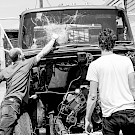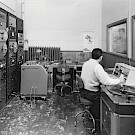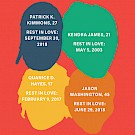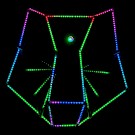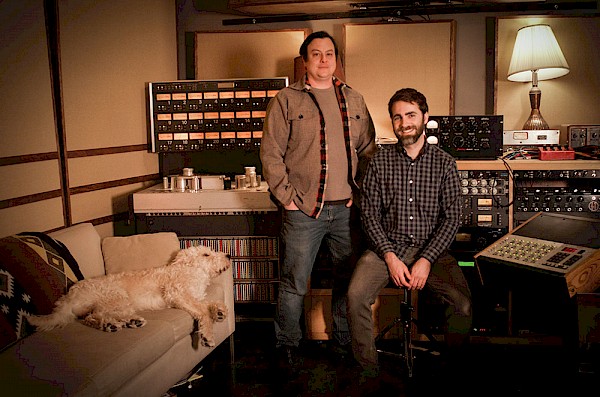 Wizards of The Map Room: Bodhi, Kris White and Josh PowellIt’s rare to find The Map Room sitting empty these days. With meticulously tuned acoustics, hand-built microphones, a vintage tape machine, custom tube gear, and a beautiful open floor plan, it’s easy to see why.
Wizards of The Map Room: Bodhi, Kris White and Josh PowellIt’s rare to find The Map Room sitting empty these days. With meticulously tuned acoustics, hand-built microphones, a vintage tape machine, custom tube gear, and a beautiful open floor plan, it’s easy to see why.
Owners Josh Powell and Kris White met on a Tape Op message board 10 years ago. White was a musician first, making four-track bedroom recordings before majoring in music production and technology as an undergrad. Powell spent five years learning about circuits, microphones and how audio gets from one place to another while working for Hamptone, the Portland-based boutique pro audio manufacturer. Their working dynamic makes the most of their complementary backgrounds, which one might describe as scientifically informed artistry—a dynamic readily apparent at their studio.
“We redid most of our acoustic treatment four or five years ago,” Powell says. “It’s not like anything was sounding bad... but we felt like we could take it further.” Starting over from scratch with a calculated approach, “We did testing at every step along the way in multiple parts of the room to see if there were any modes or standing waves, and also to see how different frequencies would decay over time so we could make a really even room response,” Powell recollects. “We must have done a hundred tests!” He adds, “I feel like the math, or the charts and plots helped guide us, but in the end we were making final decisions just by listening.”
“It’s like placing a microphone,” White says. “You might have an idea of where to start, but then it’s listening! You know, like getting the snare drum out, clapping your hands. That’s how we did the last 10 to 20 percent of the process.”
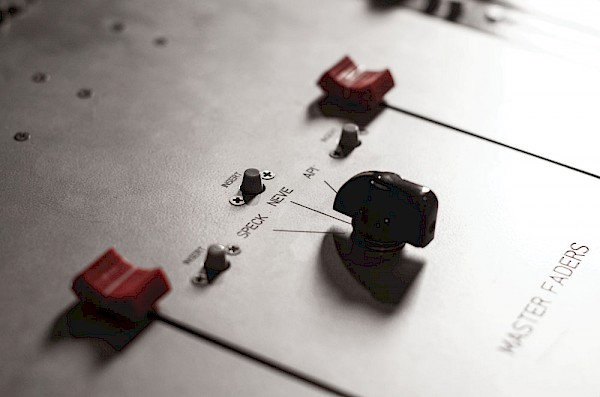 "Instagram filters for your audio!" The Map Room offers a mixing board that can switch between Speck, Neve or API circuitry.It was worth it. “I had a very heavy-handed drummer on a session a few weeks ago,” White tells. “He hit [the cymbals] so hard, but the room was so balanced, they just went on forever. It was so pretty I was forgetting what the song was and was just like, ‘Listen to that decay!’” he laughs. “You have to work really hard to make something sound bad in there.”
"Instagram filters for your audio!" The Map Room offers a mixing board that can switch between Speck, Neve or API circuitry.It was worth it. “I had a very heavy-handed drummer on a session a few weeks ago,” White tells. “He hit [the cymbals] so hard, but the room was so balanced, they just went on forever. It was so pretty I was forgetting what the song was and was just like, ‘Listen to that decay!’” he laughs. “You have to work really hard to make something sound bad in there.”
Commercial studios often have great sounding rooms, but what really sets The Map Room apart is the gear, most of which Powell has either modified or built himself. “We have a bunch of tube microphones,” Powell says. “All of those I’ve built, and a few of them I’ve designed. They’re pretty classic designs, based on Neumann and AKG elements. I’m trying to find the things that everyone did best and make the microphone a marriage of those things. I set it up, bias the tube, and pick the transformer based on what sound I want to hear.”
He also modified their mixing board—a Speck M72—by adding two additional summing paths, allowing engineers to easily switch between Neve, API or the original Speck circuitry. “Instagram filters for your audio! That’s my layman’s version of what it does,” Powell explains. “It’s fun to be able switch between those and think, ‘I like the compression on the Neves, but then the snare pops in this really nice way on the APIs.’”
The studio boasts a Studer A800 reel-to-reel acquired from the famous Bearsville Sound Studio outside of Woodstock. “Bands like The Rolling Stones, Alice Cooper, The Band, Patti Smith,” Powell lists, “I suspect this machine was used on almost all of those records.” He’s set up the outputs to track to Pro Tools and tape simultaneously, and they keep a couple house reels on hand for guest engineers to use if clients can’t afford their own.
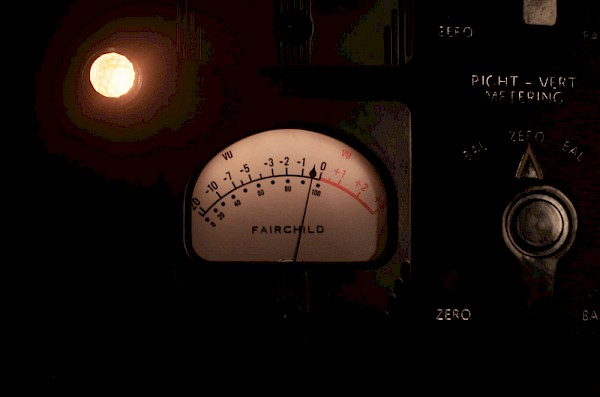 The pièce de résistance: Powell’s reproduction of the historic Fairchild 670 compressor-limiterThe pièce de résistance, though, is Powell’s reproduction of the historic Fairchild 670 compressor-limiter, arguably the most iconic of all dynamics processors. “It’s a total game changer!” White enthuses. With originals almost nonexistent, and most reproductions prohibitively expensive, it’s practically unheard of to come across one in a modern studio. And there’s only one place in Portland where you’ll find it. Lucky for us, we have a map.
The pièce de résistance: Powell’s reproduction of the historic Fairchild 670 compressor-limiterThe pièce de résistance, though, is Powell’s reproduction of the historic Fairchild 670 compressor-limiter, arguably the most iconic of all dynamics processors. “It’s a total game changer!” White enthuses. With originals almost nonexistent, and most reproductions prohibitively expensive, it’s practically unheard of to come across one in a modern studio. And there’s only one place in Portland where you’ll find it. Lucky for us, we have a map.



